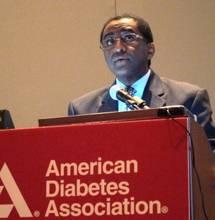CHICAGO – Insulin dose does not appear to be the culprit behind the excess cardiovascular deaths observed among type 2 diabetes in the pivotal ACCORD trial, according to a new analysis involving 10,163 patients.
In an unadjusted hazard model, an increase in daily insulin dose by 1 U/kg of body weight was associated with a significant 1.8- to 3.4-fold increased risk of cardiovascular death.
After adjustment for a series of baseline and on-treatment covariates in four subsequent models, however, no association between insulin dose and CV death was found, Dr. Elias Siraj reported at the annual scientific sessions of the American Diabetes Association.
Several post hoc analyses of the ACCORD (Action to Control Cardiovascular Risk in Diabetes) data have so far failed to explain why aggressively driving down hemoglobin A1c levels below 6% did not cut cardiovascular events, but instead raised CV mortality by 35% and all-cause mortality by 22% (N. Engl. J. Med. 2008;358;2545-59).
Some theorized that the low HbA1c levels achieved with intensive treatment might be the cause, but a recent analysis reported that a higher average HbA1c in ACCORD was actually associated with a greater risk of death, particularly in the intensive treatment arm (Diabetes Care 2010;33:983-90).
Based on the study protocol, the investigators anticipated that within the intensive treatment arm, patients with higher HbA1c would be on a higher dose of insulin, and thus, began zeroing in on insulin dose as a potential cause, explained Dr. Siraj, director of the diabetes program, endocrinology section, Temple University, Philadelphia.
Data were analyzed for 10,163 patients with updated average daily dosage of total, basal, and prandial insulin, expressed as U/kg of body weight, and follow-up data for cardiovascular (CV) mortality and insulin dose with a mean follow-up of 5 years. As previously reported, all three insulin doses were higher in the intensive treatment arm than the standard arm in which HbA1c was targeted to 7%-7.9%.
In the unadjusted Cox proportional model, insulin exposure significantly increased the risk for CV mortality for total insulin (hazard ratio, 1.83), basal insulin (HR, 2.29), and bolus insulin (HR, 3.36; all P less than .0001).
Adjusted analyses
After adjustment, however, for 14 baseline characteristics including HbA1c, age, history of cardiovascular disease, HDL cholesterol, diabetic complications, serum creatinine, and urinary albumin-to-creatinine ratio, the hazard ratios dropped and the statistical significance was lost for total (HR, 1.21; P = .17), basal (HR, 1.3; P = .20), and bolus (HR, 1.65; P = .11) insulin, Dr. Siraj said during the presidential oral session.
Adding assignment to a blood pressure and lipid trial, severe hypoglycemia and weight change to model 2 did little to budge the hazard ratios (total HR, 1.21; P = .19), (basal HR, 1.29; P = .22) and (bolus HR, 1.63; P = .13).
There was a slight change after adjusting for updated average HbA1c in model 3, but again, the association between total (HR, 1.12; P = .45), basal (HR, 1.13; P = .56), and bolus (HR, 1.48; P = .23) insulin and CV death remained statistically nonsignificant, he said.
The same was true after adding glycemic treatment assignment in the fourth and final model (total HR, 0.99; P = .96), (basal HR, 0.94; P = .79), and (bolus HR, 1.23; P = .54).
"These results do not support the hypothesis that insulin dose is an independent risk factor for CV mortality in this population," Dr. Siraj concluded.
Why the question remains unanswered
Several audience members questioned the conclusion on a variety of fronts, including reverse causality, meaning that people who are sick require higher doses of insulin because they’re more insulin resistant, and if they’re sick to begin with, that’s the cause of the death. One attendee suggested that the data were overanalyzed in the models and called for the all-cause mortality data, while another went so far as to ask the investigators to release the entire ACCORD data set for others to analyze.
"I don’t think I said that we disproved a relationship, but that we didn’t see an association," Dr. Siraj responded. Acknowledging the limitations of a post hoc analysis, he mentioned that this is a routine way of looking into possible associations and that the result will contribute toward the debate, even though it may not give a definitive answer. While there are various ways of choosing models to adjust for covariates, the modeling approach they followed was reasonable, as it took away the potential role of baseline covariates as well as on-treatment factors, he added.


